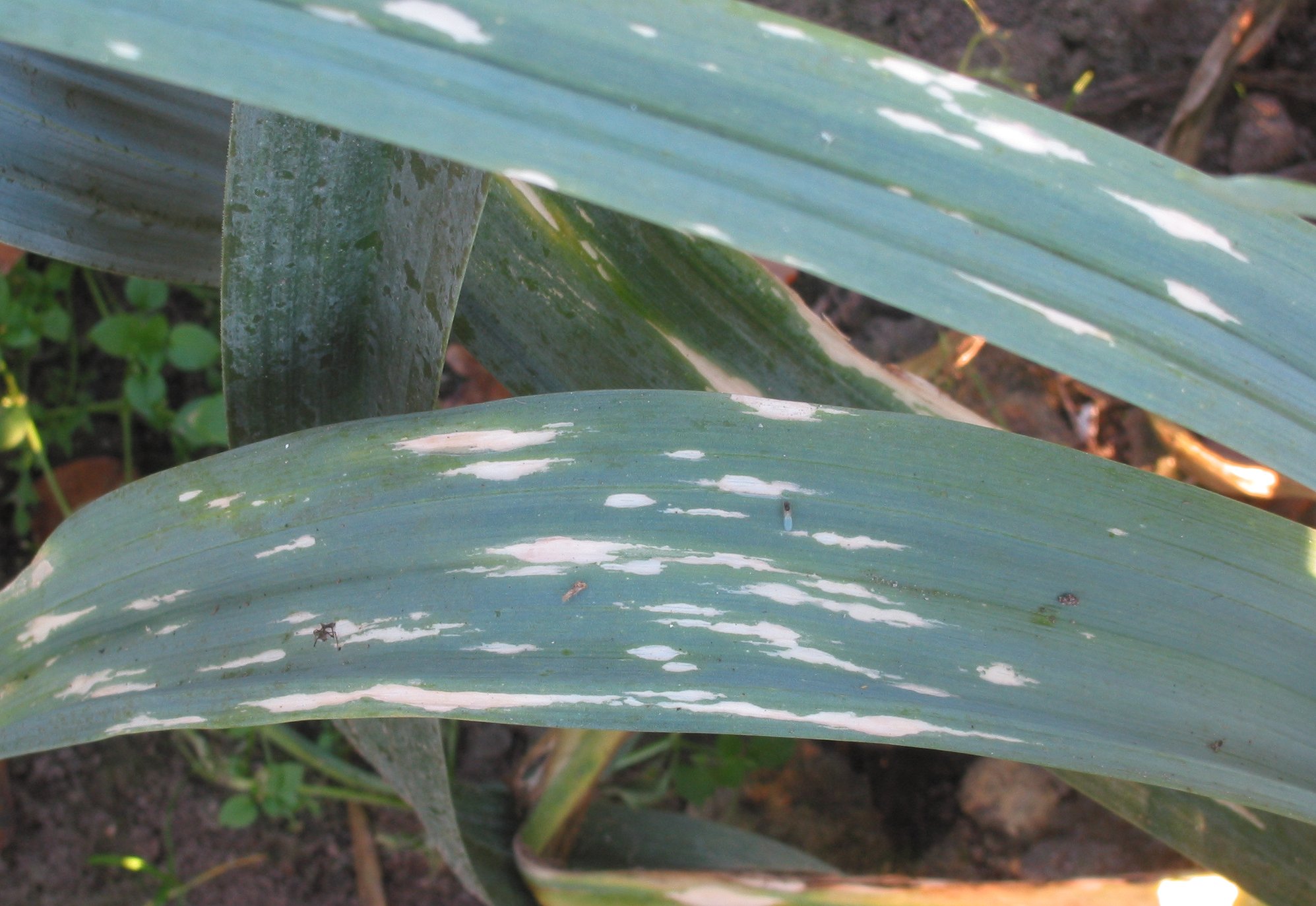- Phytophthora
Taxobox
name = "Phytophthora"

image_width = 250px
image_caption = "Phytophthora porri" on leek ("Allium porrum")
domain =Eukaryota
regnum =Chromalveolata
phylum =Heterokontophyta
classis =Oomycetes
ordo =Peronosporales
familia =Pythiaceae | genus = "Phytophthora"
subdivision_ranks = Species
subdivision = "Phytophthora arecae " "Phytophthora botryosa " "Phytophthora brassicae " "Phytophthora cactorum " "Phytophthora cajani " "Phytophthora cambivora " "Phytophthora capsici " "Phytophthora cinnamomi " "Phytophthora citricola " "Phytophthora citrophthora " "Phytophthora clandestina " "Phytophthora colocasiae " "Phytophthora cryptogea " "Phytophthora drechsleri " "Phytophthora erythroseptica " "Phytophthora fragariae " "Phytophthora gonapodyides " "Phytophthora heveae " "Phytophthora humicola " "Phytophthora idaei " "Phytophthora ilicis " "Phytophthora infestans " "Phytophthora inflata " "Phytophthora iranica " "Phytophthora katsurae " "Phytophthora lateralis " "Phytophthora medicaginis " "Phytophthora megakarya " "Phytophthora megasperma " "Phytophthora melonis " "Phytophthora mirabilis " "Phytophthora multivesiculata " "Phytophthora nicotianae " "Phytophthora palmivora " "Phytophthora phaseoli " "Phytophthora porri " "Phytophthora primulae " "Phytophthora pseudotsugae " "Phytophthora quercina " "Phytophthora ramorum " "Phytophthora sinensis " "Phytophthora sojae " "Phytophthora syringae " "Phytophthora tentaculata " "Phytophthora trifolii " "Phytophthora vignae ""Phytophthora" (from Greek phytón, “plant” and phthorá, “destruction”; “the plant-destroyer”) is a
genus of plant-damagingProtist s of the "Oomycetes" (water mold s). Heinrich Anton de Bary described it for the first time in 1875.Pathogens
"Phytophthoras" are mostly pathogens of
dicotyledon s, and are relatively host-specific parasites. Many species of "Phytophthora" areplant pathogen s of considerable economic importance. "Phytophthora infestans " was the infective agent of the potato blight that caused the Great Irish Famine (1845-1849). Plant diseases caused by this genus are difficult to control chemically, thus resistantcultivar s are grown as a management strategy. Research beginning in the 1990s has placed some of the responsibility for European forest die-back on the activity of imported Asian "Phytophthoras". [ [http://www.sueddeutsche.de/,tt4m2/panorama/artikel/951/52899/ "Phytophthora: Asiatischer Pilz lässt die Bäume sterben" "Süddeutschen Zeitung" 11 May 2005] ]Other important "Phytophthora" diseases are:
* "Phytophthora alni " – causes alder root rot
* "Phytophthora cactorum " – causesrhododendron root rot affecting rhododendrons, azaleas and causes bleeding canker in hardwood trees
* "Phytophthora cinnamomi " - causes cinnamon root rot affecting woody ornamentals including arborvitae, azalea, Chamaecyparis, dogwood, forsythia, Fraser fir, hemlock, Japanese holly, juniper, Pieris, rhododendron, Taxus, white pine, and American chestnut
* "Phytophthora fragariae " - causes red root rot affecting strawberries
* "Phytophthora palmivora " - causes fruit rot in coconuts and betel nuts
* "Phytophthora ramorum" – infects over 60 plant genera and over 100 host species - causesSudden Oak Death [ [http://www.aphis.usda.gov/ppq/ispm/pramorum/pdf_files/usdaprlist.pdf "APHIS List of Regulated Hosts and Plants Associated with "Phytophthora ramorum" U.S. Animal and Plant Health Inspection Services] ;]
* "Phytophthora quercina " – causes oak death
* "Phytophthora sojae " - causes soybean root rotFungi resemblance
"Phytophthora" is sometimes referred to as a fungal-like organism but it is classified under a different kingdom altogether: Stramenopila (previously named
Chromista ). This is a good example ofconvergent evolution : "Phytophthora" is morphologically very similar to true fungi yet its evolutionary history is quite distinct. In contrast to fungi, stramenopiles are more closely related to plants than animals. Whereas fungal cell walls are made primarily ofchitin , stramenopile cell walls are constructed mostly ofcellulose . Ploidy levels are different between these two kingdoms as are biochemical pathways.Biology
"Phytophthoras" may reproduce sexually or asexually. In many species, sexual structures have never been observed, or have only been observed in laboratory matings. In homothallic species, sexual structures occur in single culture. Heterothallic species have mating strains, designated as A1 and A2. When mated, antheridia introduce gametes into oogonia, either by the oogonium passing through the antheridium (amphigyny) or by the antheridium attaching to the proximal (lower) half of the oogonium (paragyny), and the union producing oospores. Like animals, but not like most true Fungi, meiosis is gametic, and somatic nuclei are diploid. Asexual (mitotic) spore types are chlamydospores, and sporangia which produce zoospores. Chlamydospores are usually spherical and pigmented, and may have a thickened cell wall to aid in its role as a survival structure. Sporangia may be retained by the subtending hyphae (non-caducous) or be shed readily by wind or water tension (caducous) acting as dispersal structures. Also, sporangia may release zoospores, which have two unlike flagella which they use to swim towards a host plant.
Notes
*Department of Environment and Conservation, Western Australia - Dieback [http://www.naturebase.net/content/category/4/302/97/]References
* Lucas, J.A. "et al." (eds.) (1991) "Phytophthora" based on a symposium held at Trinity College, Dublin, Ireland September 1989. British Mycological Society, Cambridge University Press, Cambridge, UK, ISBN 0-521-40080-5 ;
* Erwin, Donald C. and Ribeiro, Olaf K. (1966) "Phytophthora Diseases Worldwide" American Phytopathological Society Press, St. Paul, Minnesota, ISBN 0-89054-212-0
* Erwin, Donald C. (1983) "Phytophthora: its biology, taxonomy, ecology, and pathology" American Phytopathological Society Press, St. Paul, Minnesota, ISBN 0-89054-050-0
* [http://www.aphis.usda.gov/ppq/ispm/pramorum/pdf_files/usdaprlist.pdf "APHIS List of Regulated Hosts and Plants Associated with "Phytophthora ramorum" U.S. Animal and Plant Health Inspection Services]External links
* [http://www.btny.purdue.edu/USDA-ARS/Goodwin_lab/results/Phytoph_biblio.html Goodwin, Stephen B. (January 2001) "Phytophthora Bibliography" Purdue University] ;
* [http://www.ladybug.uconn.edu/factsheets/tp_05_phytophthora.html Abbey, Tim (2005) "Phytophthora Dieback and Root Rot" College of Agriculture and Natural Resources, University of Connecticut] ;
Wikimedia Foundation. 2010.
